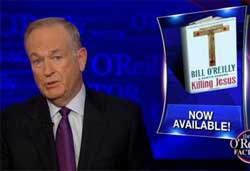 |
| Media Photo |
In his well – researched text on the Christ story entitled Killing Jesus, Bill O’Reilly takes a humanistic and multi – disciplinary approach to this story and its details and plot, characters and principal actors. His investigative work and story – telling re – visit the integral parts of this Christian legend, and pages are filled with a rich and detailed portrayal of different features of the New Testaments’ telling of this remarkable life. Turning points and main features of the book include a depiction in detail, and this text of almost 250 pages is longer than any of the New Testament gospels, of the ideas and different informative topics about this pivotal story in Christianity and the Catholic faith, and even in Judaism for that matter - including the virgin birth, the flight into Egypt, the scene with the Christ child in the Temple with his elders, his meeting with and baptism story involving John the Baptist; the gathering of the Apostles with Christ as their spiritual and ideological leader, the emphasis upon Jesus as a humanistic and human character versus a literal miracle – worker. The story also takes into account the scenes between Christ and the Pharisees, money changers, and others at or near the Jerusalem Temple, The Sermon on the Mount, the politics of the day as ruled by the corrupt and overriding Roman regime involving various characters such as Antipas, Pilate, and the Herod kings. The story O’Reilly re – tells of the Passion and Crucifixion – essentially the stations of the cross, is a colourful and enticing narrative including the legend of Christ’s tomb and the post – mortem Pentecostal time when the Lord appeared among his disciples and apostles. This invites us to investigate for ourselves the personal meaning of this cosmological view of a charismatic and political figure from the ancient world.
None of these sub – plots are told or narrated as strictly from the standpoint of one, single gospel of the Bible’s New Testament, and O’Reilly allows for the rites, symbols, mysteries and their meanings to flow through to the reader on one’s own, personal level. These details form the overall outstanding and highlighted thematics that give a very personal impression for the reader of the mysteries of modern Christianity itself that allow for the cohesion, flow and different assertions of ideas in the text. From these literary currents as told through the author’s magnifying and examining literary lens, it is clear from the text that Christ was a complete natural, a greatly charismatic person regardless of whether or not one regarded or regards him as a spirit or a human prophet. As a figure in the ancient world, especially during the time of the Roman empire, and even today, he would have eschewed not the overall role of spiritual leadership, but by his nature again would have avoided the kind of window dressing and fluff that might accompany it. For this and other reasons, and the text implies as much, the followers of the Christ, Prince of Peace, Xavier, Son of God, the Nazarene, … , while not very numerous in the origins of what was at the time the new Catholic faith; the pattern of the fervor and contagion of the Christ story starting in the old times could not have been otherwise up to today with its massively populous following among people everywhere. This begs the question about what the authors of this text, O’Reilly and Dugard, would have to write about, briefly or at length, about the story of Saint Paul, for instance as it integrates into Catholicism from the Christ story itself and again the meaning these narratives have in the modern Catholic faith, in the doctrine and among the laiety. This review is after a reading and is not overall an endorsement nor rebuke of the ideas, themes, and topics, etc., discussed by the authors in the text. Overall an excellent book.
No comments:
Post a Comment